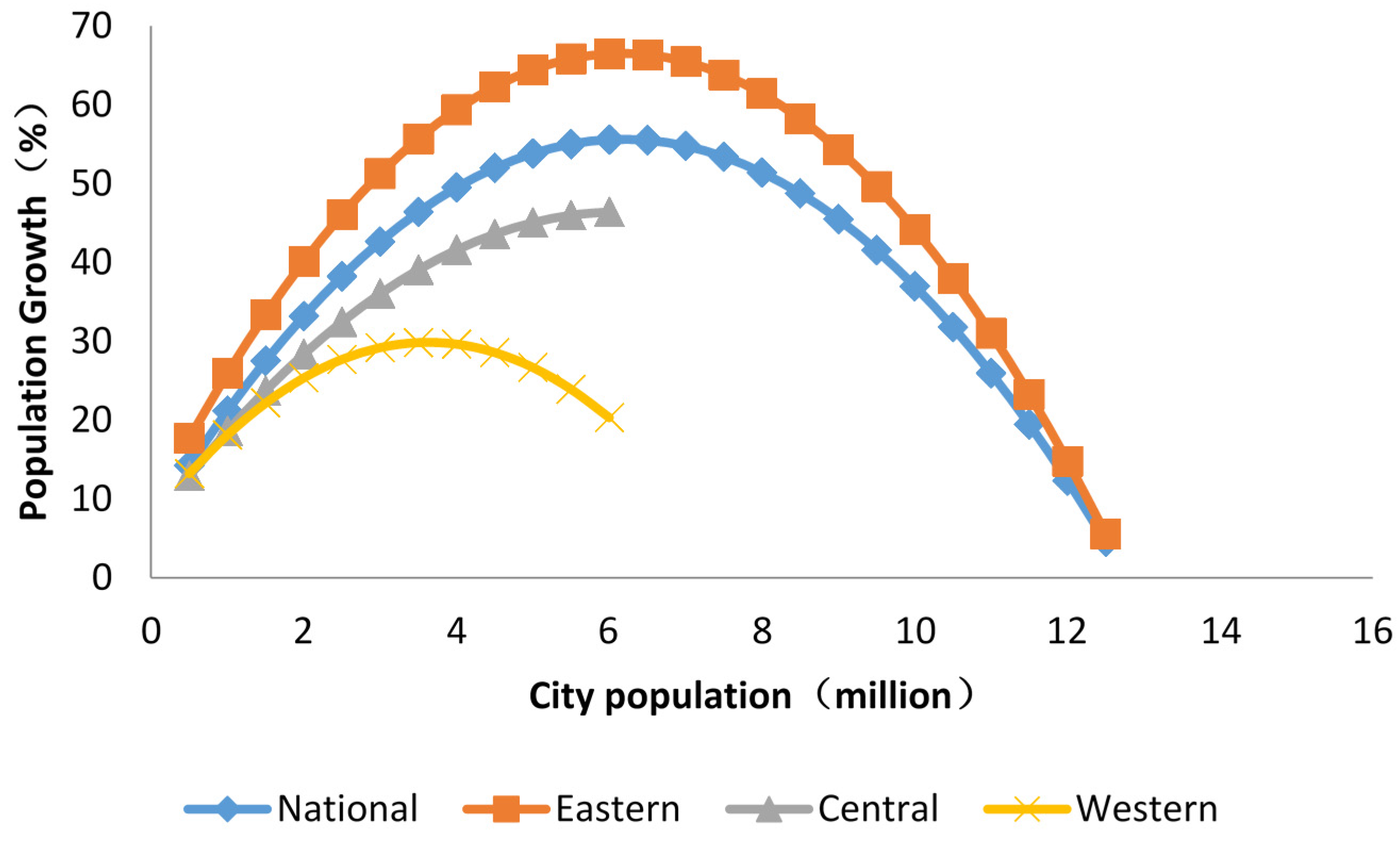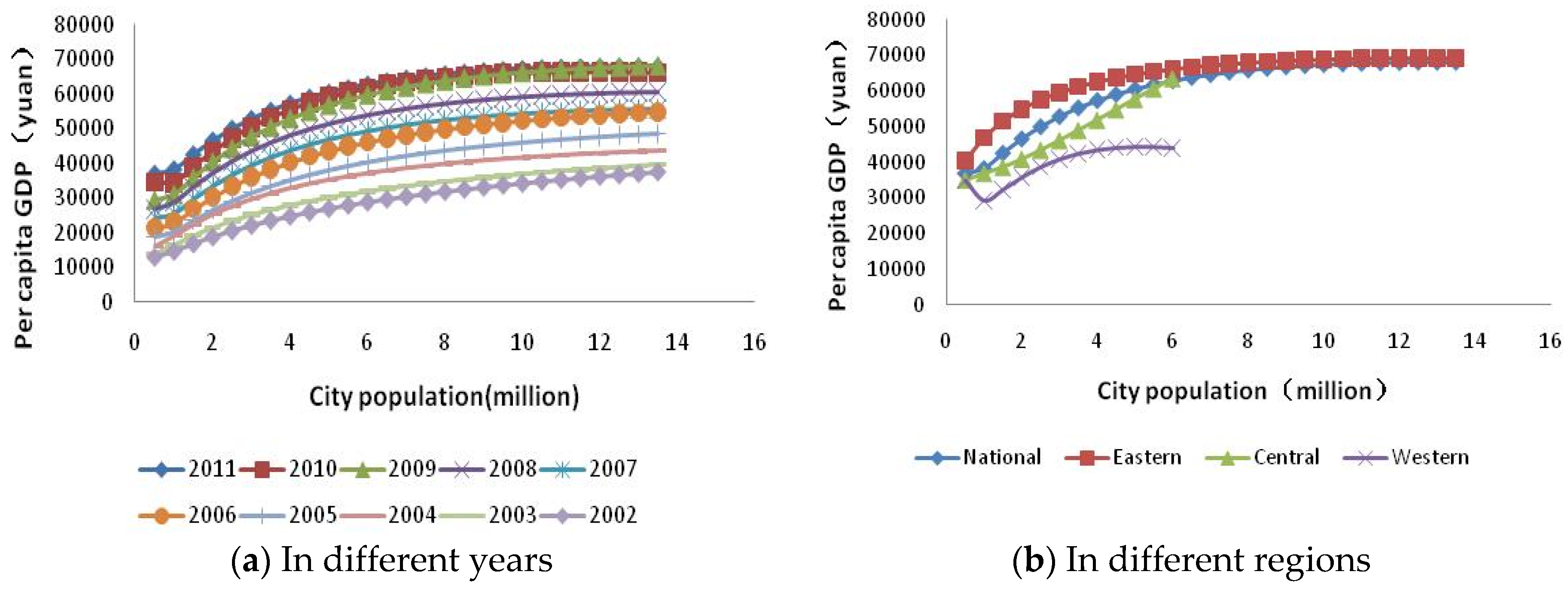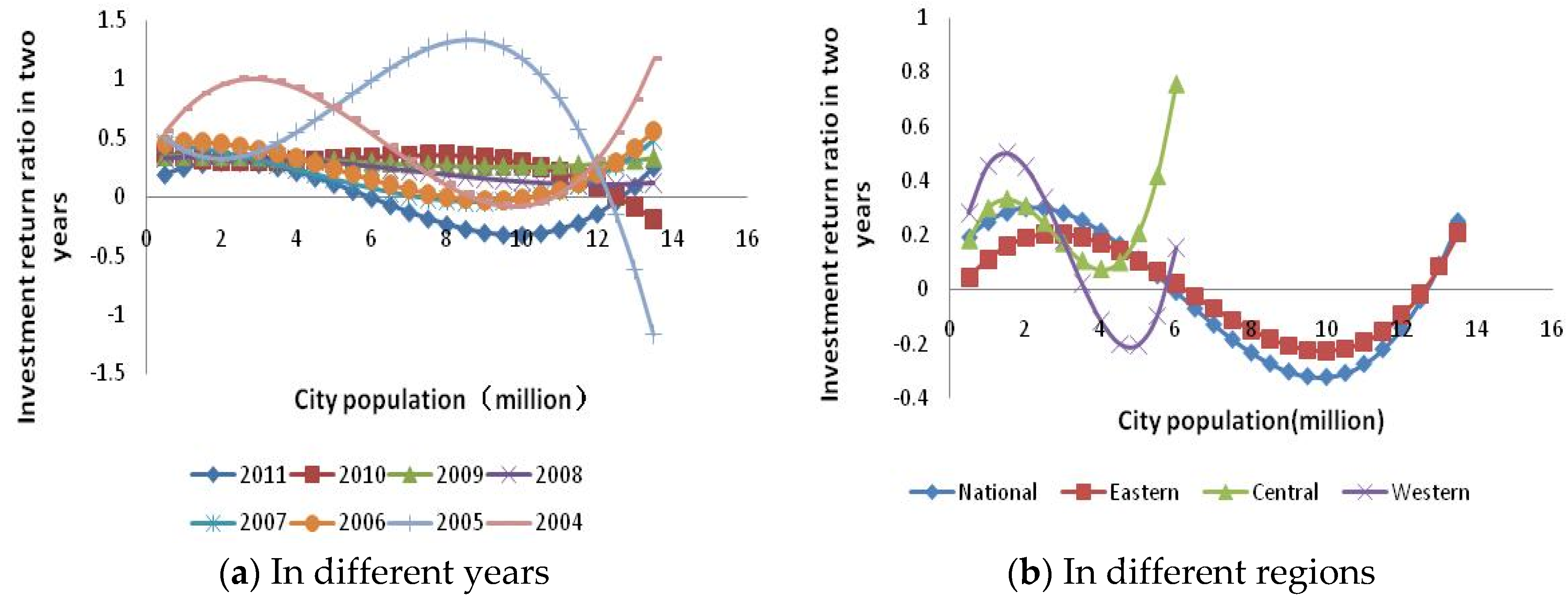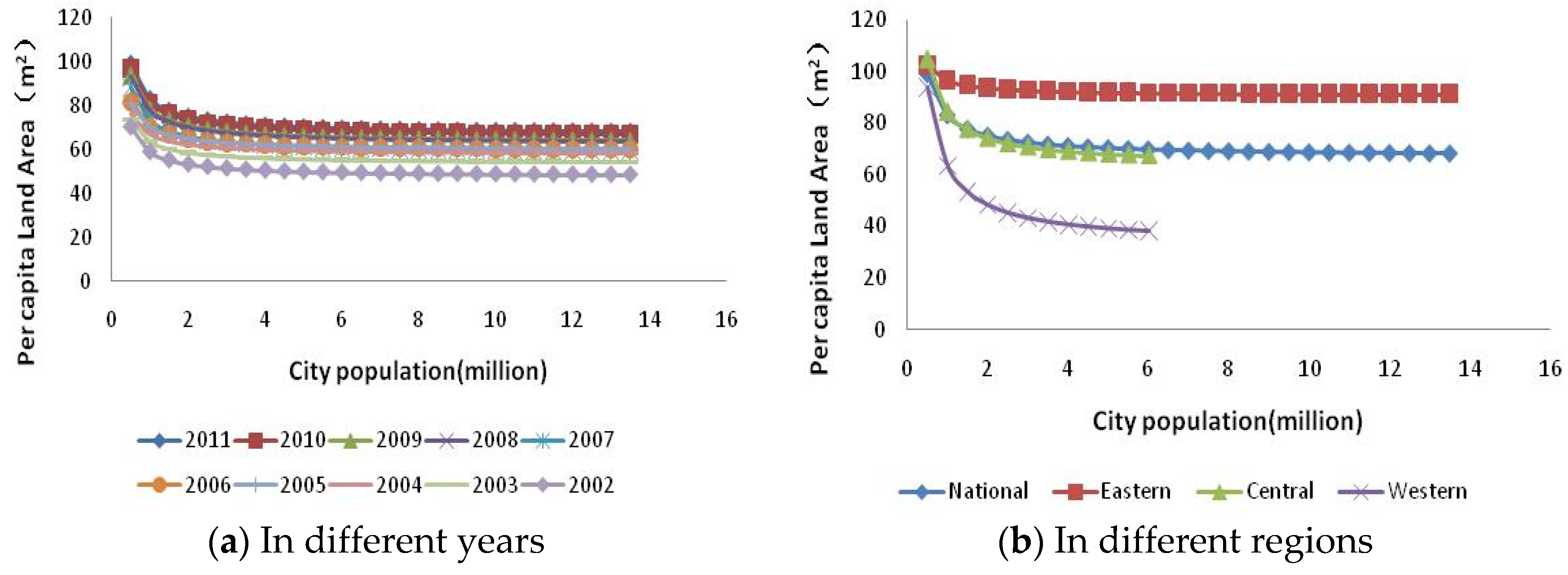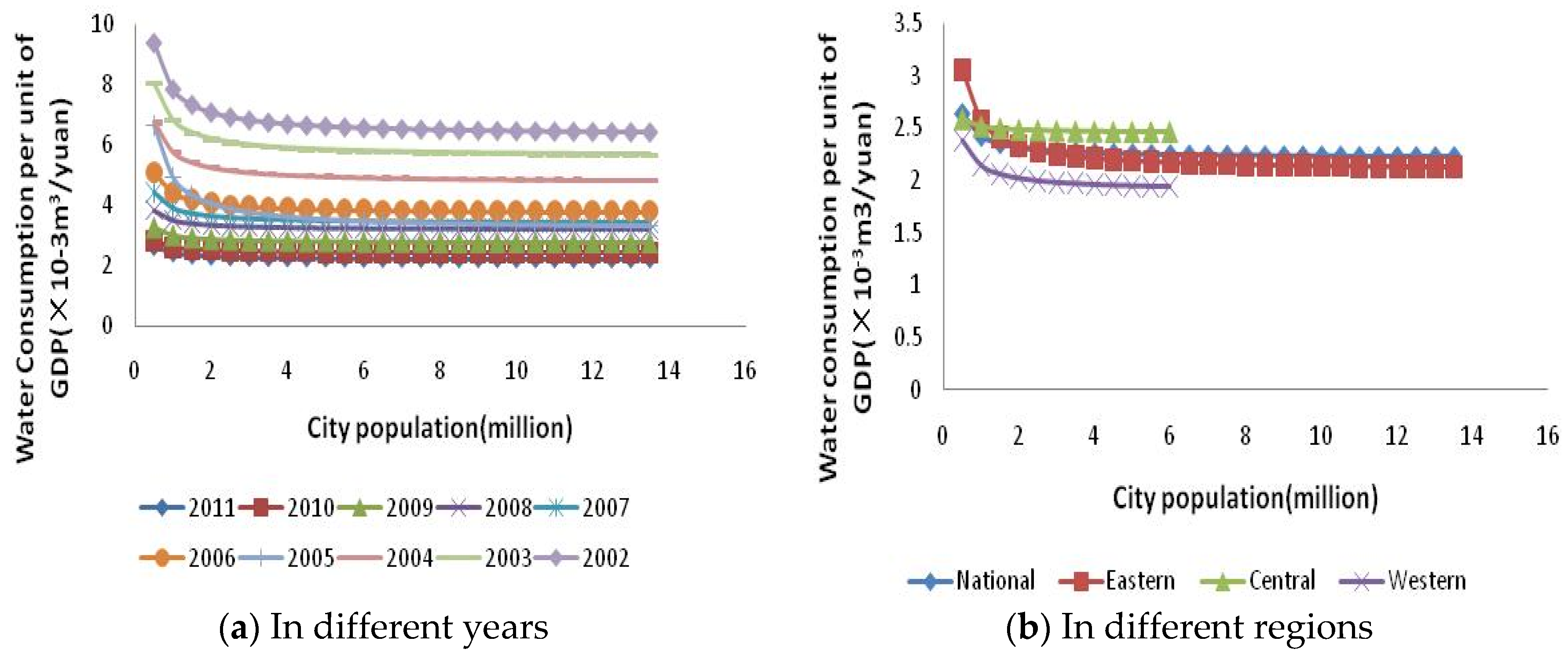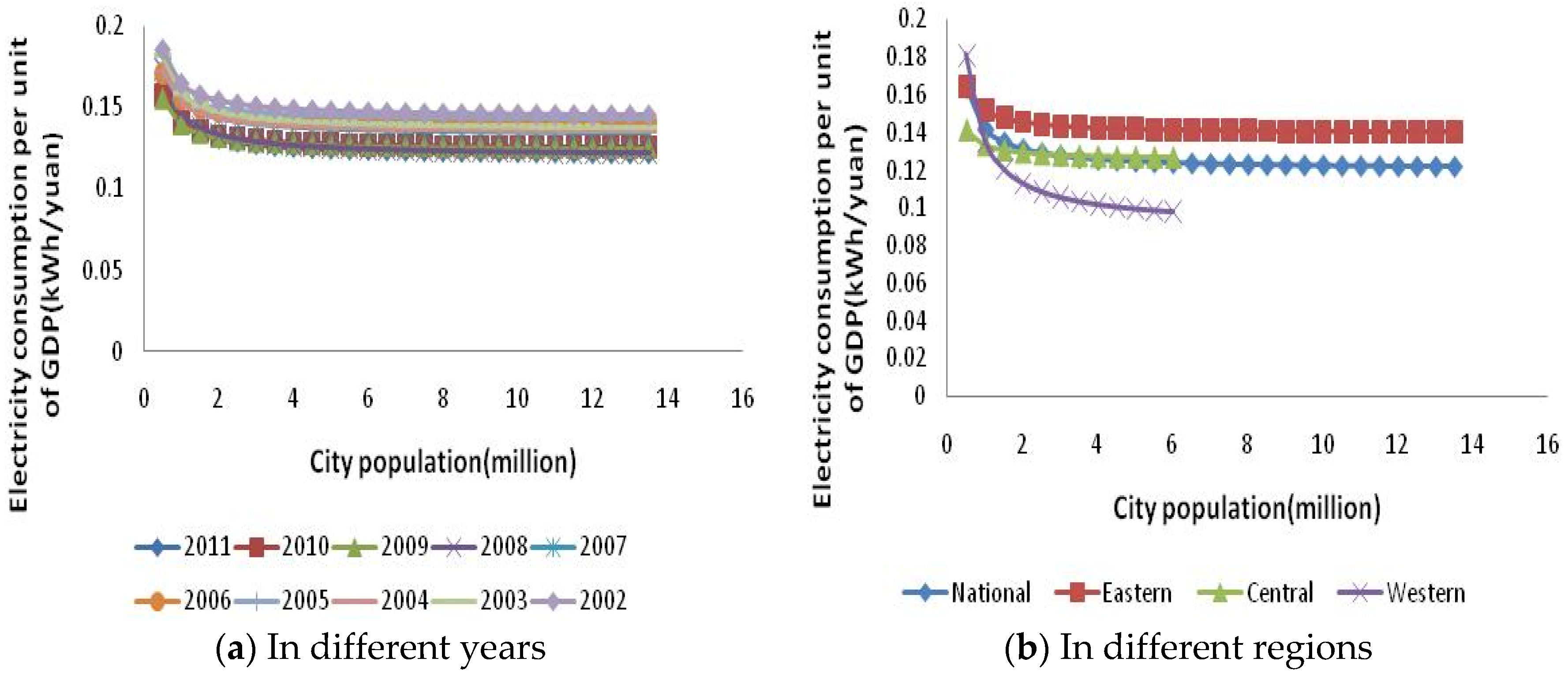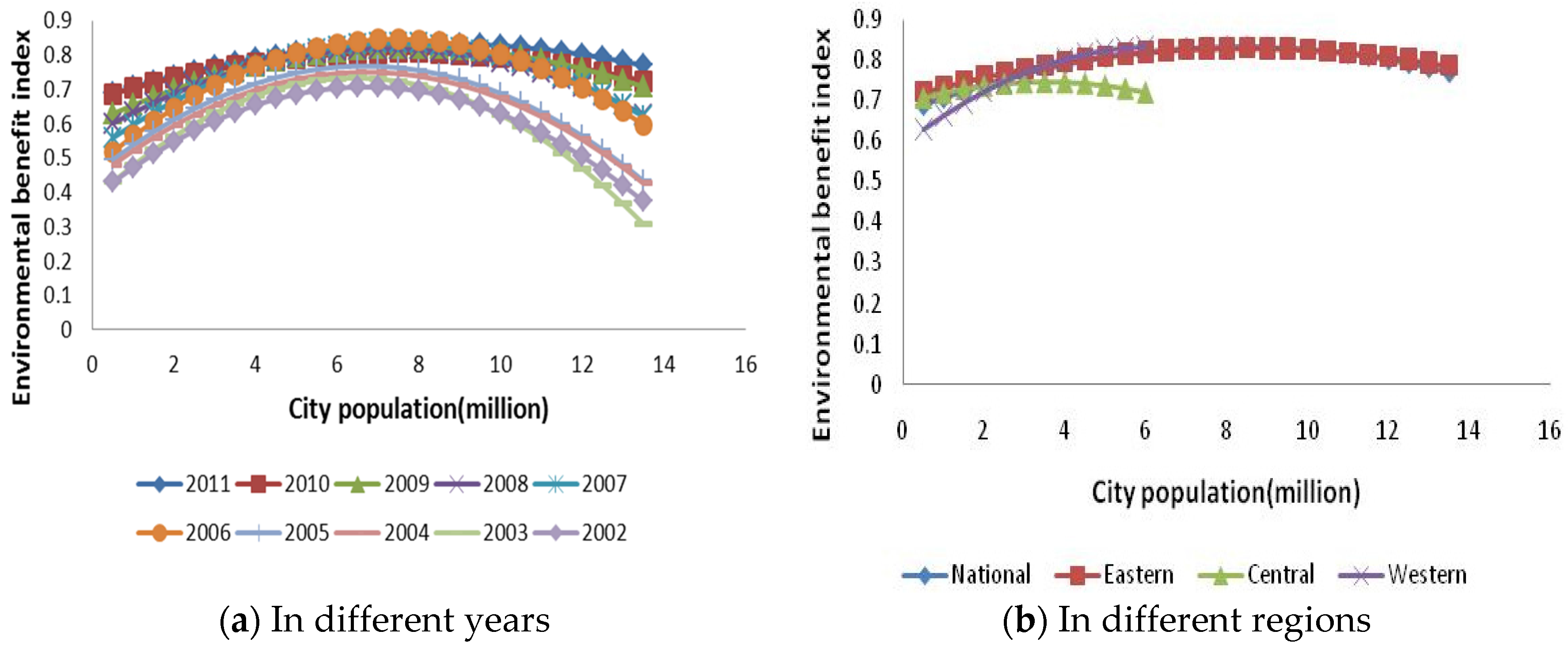1. Introduction
In March 2014, China introduced new strategic urban planning guidelines mandating “full liberalization of the household registration restraints in townships and small cities, gradual liberalization of the restraints in cities with a population of 0.5–1 million, and strategic liberalization of the restraints in big cities with a population of 3–5 million, and strategic determination of the conditions of household registration in the big cities, and strict control the urban population in large cities with a population of over 5 million.” The new urban planning guidelines revived the discussion in China on urban size policy and its economic and ecosystem benefits.
China has experienced rapid urbanization in the last few years. According to the China Statistical Yearbook [
1], the urbanization rate increased from 17.92% in 1978 to 52.57% in 2012. During this period, approximately 500 million people moved from rural areas to cities, and the number of big cities with populations of more than 1 million increased from 15 to more than 100. This rapid urbanization has been largely driven by China’s urbanization policies [
2]. Thus, China’s urbanization policies, particularly policies regarding city size, have begun attracting the attention of politicians and academics. Ratified by the State Council in 1980, the Proceedings of the National Urban Planning Conference stressed that “we should control metropolitan scale, rationally develop the medium-sized cities, and actively develop small cities.” The Urban Planning Law was implemented on 1 April 1990, and the guiding principle of urban development was legally clarified, stating that “to strictly control the scale of large cities, rationally develop medium-sized cities and small cities." This law is still in effect and provides the legal basis of the government’s city size policies. However, this law has failed to meet China’s urban development needs. Therefore, development has not conformed with the aforementioned prescriptions designed by these strategic plan [
3].
It is, thus, necessary to analyze the impact of China’s urban population on urban economic and ecosystem services benefits. Based on this analysis, recommendations for the optimization of urban development policy will be made to improve the rationale of decision-making in urban development and to enhance the development capacity of cities.
Rashevsky was the first to investigate city size issues and proposed a theoretical model for reasonable city size within a specific region from the perspective of the relationship between the city and the region. However, it was not until the late 1960s that more research on this topic began to emerge [
4]. Tolley constructed a model demonstrating how city size affects income and cost of living, and believed that because the political preferences of government officials indirectly influenced spatial policy, optimal city size did not exist in a sub-optimal world in which externalities were not fully internalized [
5]. Henderson assigned various production functions to each of the cities and found that the optimal solution was likely not the only value but was rather a range of values [
6]. Camagni
et al. constructed a comprehensive model to measure the reasonable size of cities, taking into account quality of life, industrial diversity, and degree of social harmony [
7]. Since the 1980s, various scholars have conducted empirical studies on the benefits of city size in various countries and regions and obtained optimal city size ranges for the respective regions [
8,
9,
10,
11,
12,
13,
14]. Meanwhile, with the continuous focus on global resources and environmental issues, the impact of resources and environment on urban development has been examined in studies of the benefits of city size. The relationships between city size and urban heat islands [
15], air quality [
16], resource consumption [
17,
18], and environmental pollution costs were quantitatively investigated [
19,
20].
Studies on the benefits of city size in China can be divided into two phases. The first phase began in the 1980s, when proponents of small cities and proponents of large cities began to clash. The rationale behind small cities was mainly an argument concerning “special situations of the nation and cities”. Small-cities proponents asserted that various urban problems existed in China’s large cities. Additionally, small-cities proponents argued that due to close geopolitical relationships, the cost to farmers to enter small cities was lower than it was to enter medium and large cities, thus lowering the cost of urbanization. Further, the development of rural secondary and tertiary industries can be promoted so that a large number of rural surplus laborers can be accommodated in small cities. In 1984, Xiaotong Fei published a series of investigative reports titled “Small towns but big problems” arguing that the development of small towns should be the main focus of urbanization in China [
21,
22],. Fei’s assertion catalyzed widespread national debates. Proponents of big cities noted the shortcomings in the arguments of the proponents of small cities stemming from having ignored the benefits of large city size, arguing that big cities have much larger scale efficiency than small cities. Based on studies of other countries’ urbanization processes, big-cities proponents believe that there exist “objective rules of advanced development of big cities” and that China should focus on developing big cities. Hu argued that the advanced development of big cities is a statistical rule and that their rapid development is a global trend [
23]. Rao and Cong argued that large cities offer better economic, social, environmental, and architectural benefits than small and medium cities and that city size efficiency is an important and universal rule that should be used to accelerate urbanization [
24]. Yu reemphasized that the “advanced growth of big cities” was a universal rule and believed that “developing big cities and intensive development are the only ways of urbanization in China.” Thus, the reasonable choice was to actively and selectively develop large cities [
25].
The second phase of urbanization in China began in the mid-1990s, when research was no longer limited to conceptual city size and was more quantitative. Chen and Jiang used the cost-benefit curve of city size generated by Barton (an urban economist) to quantitatively analyze the panel data of 666 cities nationwide and concluded that the size of cities with maximum net scale benefits was 1–4 million,
i.e., the optimal size of the city [
26]. Wang and Xia noted that large cities have significant net scale benefits and that optimal city size was between 0.5–4 million, with the peak value ranging between 1 and 2 million [
27]. Ma and Song argued that, except for Beijing, Shanghai, and Tianjin, three mega-cities with relatively high-scale benefits and sustainable development capacity, mega- and large cities with populations of 1–2 million and 0.5–1 million, respectively, rank high in both scale benefits and sustainable development capacity [
28]. By conducting an empirical analysis using relevant city data from 1995–1996, Rao and Cong concluded that optimal city size in China is approximately 6.5 million and that technological progress and institutional innovation tend to increase the optimal size [
29]. Based on the input-output differences in the three critical elements of capital, land, and labor of cities of different sizes, Yu used the entropy-DEA method and concluded that after the urban population reached 50,000, economic efficiency significantly improved, whereas cities with a population of less than 30,000 had low utilization efficiency in public facilities and poor investment returns [
30]. Zheng performed the regression analysis on the actual change in the relationship between city size and per capita GDP, per capita investment, per capita net income, and per capita input-output net income and found that the reasonable and efficient size of regional major cities ranged between 1.5 and 2.7 million [
31]. Yan and Feng demonstrated that accelerated growth in city size after 2000 encouraged the development of large cities [
32]. Sun
et al. researched the relationship between cost of production and city size of population by constructing a per unit production coat function, and finding that large cities were more productive and the optimal city population size was 4.2 million [
33].
China is a resource-short country by per capita resources, where water per capita is only 1/4 of the global average and per capita arable area is 40% of the global average. The problems of resource limits become serious with the fast development of urbanization. Therefore, researches on Chinese urbanization and resource consumption have shown a rapid increase this century. Varis and Vakkilainen’s research showed that increasing demand of agricultural products, continuous deterioration of the ecological environment, and the threat of climate change would be a huge challenge to Chinese resources, and Chinese environmental pressure had already exceeded its capacity [
34]. Shen
et al. developed a model to describe the relationship of urbanization, economic development, and resource supply, and predicted a supply-demand relationship of resources from 2005 to 2050 [
35]. Xu gave panel regressions of relationship between city size and resources efficiency [
36]. Hong
et al. measured the relationship between Chinese city size and energy [
37]. Han
et al. researched Chinese city size and PM2.5 pollution and found that there was an inverse-U-type relationship [
38].
Much of the research has evaluated the economic or ecosystem services benefits of city size using description or model methods and has concluded on the individual optimal range of the scale, whereas previous studies on the relationship between city size and resources and environmental benefits were largely confined to an empirical model, but lacked rigorous statistical analysis. Additionally, due to China’s vast regions and rapid growth, the processes of urbanization and economic and social development taking place at different times and in different regions displayed significant variations. In this study, we embarked on a systematic and quantitative analysis of the benefits of economy and ecosystem services of cities in different times and regions to pursue more comprehensive and objective conclusions.
We established an index system that includes urban population growth, economic efficiency, efficiency of resources services, and environmental benefits. Population growth in 10 years was selected as a variable to avoid inter-annual fluctuations in population in the indicator of population growth. In terms of economic efficiency, per capita GDP and city investment-return ratio were used as variables. For the efficiency of resources services, per capita construction land use, water consumption per unit of GDP, and electricity consumption per unit of GDP were used as indicators. For environmental benefits, because the relevant individual indicator was largely irrelevant to this study, an environmental benefits index consisting of per capita green area, treatment rate of industrial solid waste, sewage treatment rate, and treatment rate of domestic garbage was used as the indicator.
Based on the models used in previous studies, in this study population growth and economic benefits were screened through linear regression to determine the most realistic regression model, then the regression analysis using the panel data was conducted to estimate the coefficients for the related indicators and to determine the optimal range of city size and the problems that actually exist. Temporal and spatial changes in the correlation coefficient and their practical significance were also analyzed. Due to significant differences in natural conditions and development status among different regions in China, the regression analysis was performed on individual cities throughout Eastern, Central, and Western China, to arrive at more detailed and realistic conclusions.
A review and summary of previous results will be presented in the next section. The relevant models used in this study will be discussed in
Section 2. The regression analysis on each of the indicators at different times and in different regions will be conducted and the differences at different times and different regions will be discussed in
Section 3. In the final section, the main conclusions and new discoveries made in this study, as well as appropriate recommendations for Chinese urbanization policy based on our findings, will be presented.
